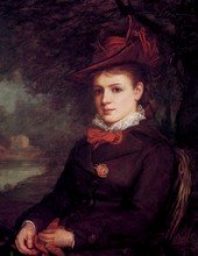
Study of a Woman
THE HUMAN COMEDY – Honoré de Balzac Second volume of works of Honoré de Balzac edited by widow André Houssiaux, publisher, Hebert and Co, successors, 7 rue Perronet – Paris (1877) Scenes from private life
ANOTHER WOMAN’S STUDY Analysis of the work The short story with the title Women’s studywhich Balzac would later use for his collection of short stories, had appeared in February 1830 in a luxury monthly, Fashion, where Devéria’s colorful, elegant “toilettes” were traditionally accompanied by spiritual “scenes” signed by well-known names. In these “pochades” written for women’s magazines, the authors generally confined themselves to delicately describing a few situations from worldly life. People’s names were often replaced by asterisks to give the impression of indiscreet anecdotes. This was the case for Etude de femme: the names of the characters in La Comédie Humaine that we can read today were assigned later by Balzac to link this story to his body of work. It’s only by chance, then, that this tale is one of Balzac’s later “études de femmes” (studies of women), which in the end never appeared and were appended to the Scènes de la vie privée collection. This brief account contains a single, ironic sketch of the pious young Parisian women from the parish of Saint-Thomas-d’Aquin, whom the Restoration’s “moral recovery” had made fashionable on the eve of the 1830 Revolution.
The story The foreword describes the customs of the wider world. First, Félicité des Touches organizes a “raout”, where the beau monde comes to show off, gossip and look good. Then, around eleven o’clock, it’s customary among the “beaux esprits” to dine together and talk without embarrassment. The Marquise de Listomère, a young woman brought up in the spirit of the Restoration, has her own principles: she takes communion, observes the fasts recommended by her religion, and goes to the ball and the Opéra all decked out. Always in tune with the church and the world, it offers an image of the present time. Married to the Marquis de Listomère, a member of parliament and a “good voter”, he was considered an excellent husband. For a woman of principles, it was difficult to fall into better hands. Having danced at a ball with Eugène de Rastignac, a charming, giddy young man, full of grace and originality. Dared by exaggerated confidence and the arrogance of youth, he had more than once looked at the Marquise in such a way as to embarrass her, leave her and never speak to her again for the whole evening. A victim of his own absent-mindedness, he mistakenly released the letter written for his mistress Madame de Nucingen in the name of the Marquise de Listomère. On reading the letter, the Marquise, thinking it an impertinence, took the formal resolution to close her door to Rastignac. First youthful mistake: Eugène found it amusing to make Madame de Listomère laugh at the misunderstanding that had made her the mistress of a love letter that wasn’t meant for her. His second mistake was to go to Madame de Listomère’s to apologize for this error four days after the adventure. Introduced to the Marquise by the Marquis de Listomère himself (unaware of the situation), Rastignac becomes his own advocate to the woman he has outraged. Finally envious of Rastignac’s love for Madame de Nucingen, Madame de Listomère refuses to see the truth, ridiculing and mocking poor Rastignac. It was only a few days later that the Marquise obtained irrefutable proof of Eugène’s veracity. Confounded, her pride put to the test, the Marquise didn’t dare show her face to the world for the next few weeks, claiming gastritis. In fact, Madame de Listomère is under house arrest because she’s having a nervous breakdown.

Eugène de Rastignac
Paris, February 1830
Genealogy of characters Listomère (de): Noble family from Touraine represented by various people, whose relationship Balzac does not specify: An elderly Marquise de Listomère, née Grandlieu, has a “serious man” son who marries his cousin, a Vandenesse, sister of Charles and Félix; A Listomère married a Vandenesse, hence Charles, Félix and the aforementioned Vandenesse; An elderly Countess de Listomère-Landon, who lived in Tours and died there in 1814. Has Balzac forgotten that she is dead, or is it someone else? We still find an “old Countess of Listomère” in 1839; An elderly Baroness de Listomère, who also lived in Tours, where she died in 1826; A Baron de Listomère, nephew of the previous baron; A young lady from Listomère. Rastignac (de): Noble family from the Angoumois region, represented by a Baron de Rastignac who lives near Angoulême. His wife’s name is unknown. From this union was born in 1798 : Eugène, student then minister and count. He married Augusta de Nucingen in 1838; Laure-Rose born in 1801 ; Agathe born 1802 ; Both married, one (Laure or Agathe) to Martial de la Roche-Hugon, the other we don’t know; Gabriel, born 1804, abbot, then bishop. Henri ; We should also mention Eugène’s great-aunt (perhaps to be identified with Mme de Marcillac) and a vice-admiral, Eugène’s great-uncle, who married a Marcillac and whose daughter married the maréchal de Clarimbault. Nucingen (de) : Baron Frédéric de Nucingen, banker born around 1763, married Delphine Goriot, born in 1792, and had a daughter Augusta who married Eugène de Rastignac.
1) Source analysis/history: Preface (Volume III) compiled from the complete text of the Comédie Humaine published by France Loisirs 1985 under the auspices of the Société des Amis d’Honoré Balzac.
2) Character genealogy source: Félicien Marceau “Balzac et son monde” Gallimard.

No Comments